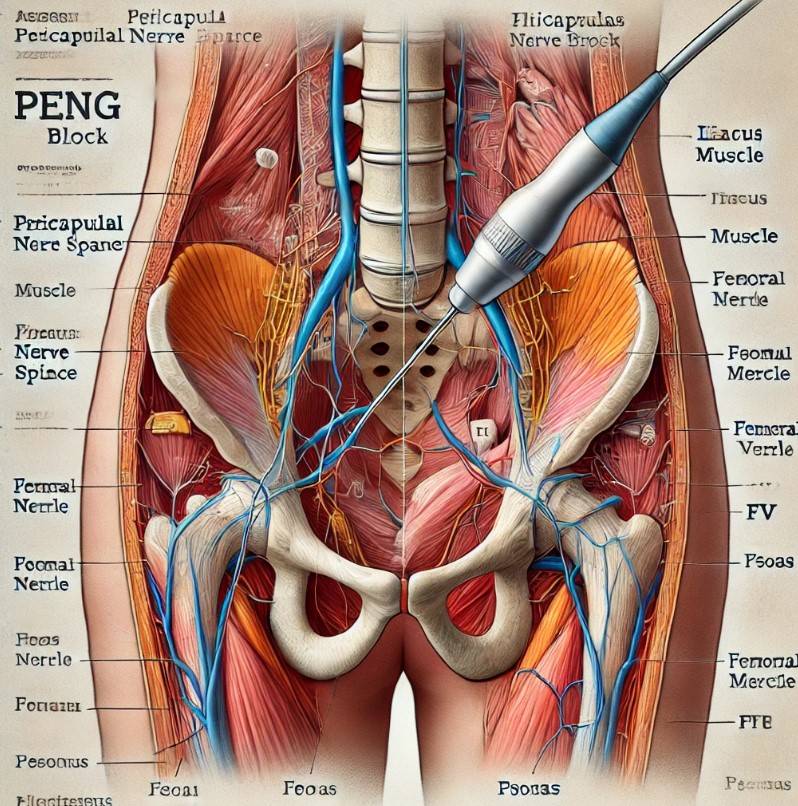Overview of the PENG Block

The pericapsular nerve group (PENG) block is a relatively new and innovative regional anesthesia technique primarily used for hip surgery and pain management. The PENG block has gained interest due to its targeted approach, efficacy in pain relief, and advantages over more traditional techniques such as epidurals and femoral nerve blocks.
The PENG block targets the nerves that supply the anterior hip capsule, which are often involved in hip pain. By blocking these nerves selectively, the PENG block provides effective pain relief without causing significant motor block. The key anatomical landmark for the PENG block is the iliopectineal eminence, which is where the local anesthetic is injected under ultrasound guidance. The goal is to bathe the nerves that innervate the hip capsule while sparing the major motor nerves that control leg movement, allowing patients to maintain mobility while receiving pain relief 1,2.
The block is performed under ultrasound guidance, which helps to increase the accuracy and safety of the procedure. The patient is typically placed in a supine position. The ultrasound probe is positioned over the groin area, and the iliopubic eminence is identified. Once the target area is located, a needle is inserted and advanced toward the eminence, and local anesthetic is injected. The procedure is relatively quick and can be performed pre-operatively or in the emergency room for trauma patients 1,2.
The PENG block is primarily indicated for procedures involving the hip, particularly in elderly patients who may not tolerate systemic analgesics like opioids due to side effects such as delirium or respiratory depression. It is also indicated for perioperative pain control in hip replacement surgeries, and for patients with chronic hip pain, among others 2,3.
One of the key advantages of the PENG block is its ability to provide targeted pain relief without causing significant motor block. This is particularly important in hip surgery, where early mobilization and rehabilitation are crucial for recovery. Another advantage is the reduction in opioid use. By providing effective regional anesthesia, the PENG block can minimize the need for systemic pain medications like opioids, which can cause nausea, constipation, and addiction 4–6.
Despite its many benefits, the PENG block has a number of limitations. Like all regional anesthesia techniques, it requires skill in ultrasound-guided procedures and an understanding of hip anatomy. There is also a risk of incomplete analgesia, especially if the anesthetic does not adequately cover all relevant nerve branches. Complications such as infection, bleeding, or nerve injury may occur, though these are relatively uncommon when the block is performed by trained professionals 2,3,7.
References
1. Kolli, S., Nimma, S., Kukreja, P. & Peng, P. How I do it: pericapsular nerve group (PENG) block. ASRA News 47, (2023).doi: 10.52211/asra080123.007.
2. Aziz, M. Ben & Mukhdomi, J. Pericapsular Nerve Group Block. StatPearls (2023).
3. Berlioz, B. E. & Bojaxhi, E. PENG Regional Block. StatPearls (2023).
4. Martínez Martín, A. et al. Benefits of analgesic blocks, PENG block (PEricapsular Nerve Group), in fast recovery after hip surgery. Rev. Esp. Cir. Ortop. Traumatol. 67, T27–T34 (2022). DOI: 10.1016/j.recot.2022.10.005
5. Benefits of Using the Pericapsular Nerve Group (PENG) Block – ACEP Now. Available at: https://www.acepnow.com/article/benefits-of-using-the-pericapsular-nerve-group-peng-block/.
6. Iacovazzo, C. et al. The Effects of the Pericapsular Nerve Group Block on Postoperative Pain in Patients with Hip Fracture: A Multicenter Study. Diagnostics 2024, Vol. 14, Page 827 14, 827 (2024).doi: 10.3390/diagnostics14080827
7. Li, S., An, J., Qian, C. & Wang, Z. Efficacy and Safety of Pericapsular Nerve Group Block for Hip Fracture Surgery under Spinal Anesthesia: A Meta-Analysis. Int. J. Clin. Pract. 2024, 6896066 (2024).doi: 10.1155/2024/6896066
